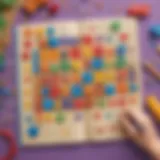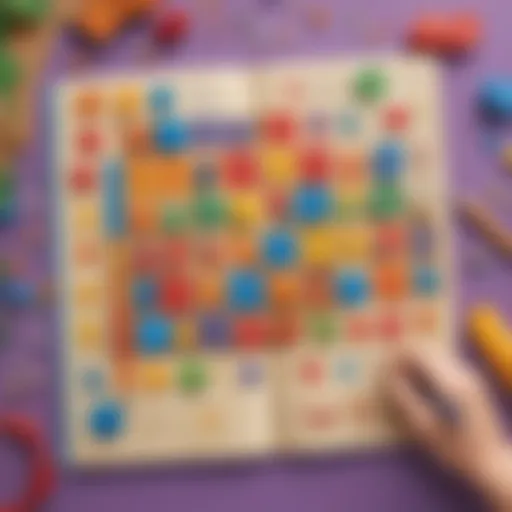Essential Historical Reads for Eleven-Year-Olds


Intro
Understanding history is more than knowing dates and events. It fosters critical thinking and helps young readers make sense of the world around them. For eleven-year-olds, the right books can spark curiosity and ignite a passion for learning. This article explores essential historical reads suitable for this age group, focusing on narratives that engage and educate.
In this section, we delve into creative activities that enhance the reading experience. We aim to provide parents and caregivers with ideas to encourage young minds to connect with history through hands-on learning. Engaging with historical themes through art and crafts not only reinforces the content but also enriches each child’s educational journey.
Creative Activities
Creative activities related to historical themes can be a fun way for children to engage with what they are learning in books. Here are some ideas that children can easily replicate.
Craft Ideas
Children can explore history by creating a timeline of important events. Simple materials like paper, crayons, and markers can invite them to illustrate key moments. Alternatively, they can recreate historical artifacts using modeling clay. Projects like these encourage creativity and reinforce knowledge of significant historical milestones.
Step-by-Step Guides
- Creating a Timeline
- Recreating Artifacts
- Gather important dates and events from a chosen book.
- Use a long piece of paper to draw a horizontal line.
- Mark the dates along the line, adding drawings or symbols to represent each event.
- Choose an artifact mentioned in a book, like a Viking shield or Egyptian hieroglyphs.
- Using modeling clay, help them mold the artifact based on descriptions or images.
- Once complete, discuss its significance in history.
Educational Value
Engaging in these activities cultivates creativity while reinforcing historical concepts. Crafting timelines helps children understand chronology, while recreating artifacts promotes discussion about the culture and technology of past civilizations.
Fun Quizzes
Quizzes can be an enjoyable method for children to assess their knowledge and deepen their understanding of history. They encourage exploration of various themes and events.
Quiz Topics
- World War II events
- Ancient Egyptian culture
- The Civil Rights Movement
- Great Explorers of the Age
Question Types
Different types of questions can keep children engaged. Multiple-choice questions might test basic knowledge, while open-ended questions allow for deeper reflection. Multiple-choice questions can help check factual recall, whereas matching questions can explore connections between events.
Knowledge Reinforcement
Quizzes provide instant feedback and can highlight areas where further learning is needed. By revisiting previously covered topics, children reinforce their learning and discover new interests.
Fact-Based Articles
Fact-based articles serve as excellent supplementary resources that expand on historical topics. These texts can help provide context and engage young minds further.
Topics
A diverse range of topics can be found in articles, such as:
- Revolutionary War facts
- Famous historical figures' biographies
- Key inventions and their impact on history
Engaging Content
The articles are designed to present information in a straightforward and relatable manner. Short paragraphs and engaging visuals enhance comprehension, making complex ideas more accessible to young readers.
Understanding the Importance of History
The value of history goes beyond just facts and dates. It is about understanding who we are and where we come from. For eleven-year-olds, the study of history can lay a crucial foundation. At this age, children are capable of grasping complex ideas, and exposing them to historical narratives can enrich their understanding of the world. By reading about different events, cultures, and peoples, children can cultivate empathy and awareness. These are vital skills as they interact with a diverse society.
A strong sense of historical context helps children make sense of current events. They are better equipped to navigate discussions about politics, culture, and social issues. History encourages critical thinking. It challenges young readers to analyze different viewpoints, the motivation behind actions, and the consequences of decisions. All this contributes to a more informed citizen.
History also serves as a mirror, reflecting our successes and failures. This reflection is essential for personal growth and academic achievement. In light of these considerations, it becomes clear: teaching history through engaging texts is not merely educational; it is an investment in the future.
Why History Matters


History matters because it offers lessons that are timeless. Everything around us, from democracies to technological advancements, stands on historical foundations. When eleven-year-olds read about past societies, they can draw parallels to their own lives. They can recognize patterns and develop insights that enhance their decision-making skills.
Additionally, knowing history helps children appreciate cultural diversity. They learn about various traditions and practices, breaking down stereotypes and building respect for different backgrounds. Understanding the complexity of past events fosters curiosity and opens dialogues about contemporary issues.
The Role of Reading in Historical Awareness
Reading is a powerful tool for cultivating historical awareness. Books transport young minds to different eras and places. Through narratives and characters, students experience events from the inside, giving them a layered understanding of history. The written word allows children to explore complex themes.
Engaging narratives encourage questions. Why did certain events unfold? How did individuals influence history? These inquiries stimulate critical thinking. In turn, students learn to draw conclusions based on their readings, enhancing their analytical skills.
Moreover, reading about history can ignite passion. This motivation can lead to broader interests in social studies and humanities. Books like "The Story of the World" or "A Young People's History of the United States" introduce historical themes in a digestible manner, making the world of history appealing and accessible. Engaging in reading about historical events prepares children to become not just better students, but informed adults.
Criteria for Selecting History Books
Selecting the right history books for eleven-year-olds is critical. At this age, children begin to form their identities and understanding of the world. Books can shape these perceptions significantly. Thus, the selection process needs to be deliberate and thoughtful.
There are several key elements to consider when choosing history books for this demographic. First, the appropriateness for age ensures that the content aligns with the child's cognitive and emotional development. If a book is too complex or mature, it may discourage reading or lead to misunderstandings about history.
Additionally, the narrative style matters. Engaging writing can spark interest and sustain attention. Lastly, diversity of perspectives enriches a young reader's comprehension of various historical narratives, fostering empathy and a broader worldview.
Appropriateness for Age
When selecting history books, age appropriateness is paramount. Content must not only be suitable for eleven-year-olds in terms of language but also thematic elements must be accessible. Books that include complex concepts or intense subjects may not resonate with this age group, potentially leading to confusion or disengagement.
Focusing on age-appropriate content encourages a positive reading experience. Historical fiction and non-fiction that present facts and characters relatable to eleven-year-olds create a connection. This connection is crucial as it helps them make sense of historical events and figures. The goal is to build a framework of understanding that they can later expand as they grow older.
Engaging Narrative Style
An engaging narrative style is vital in history books for children. A well-crafted story can transform mundane facts into memorable events. It is essential for authors to use a voice that resonates with young readers, drawing them into the narrative.
Books should contain relatable characters who face challenges reflecting broader historical themes. This approach helps children see history not just as a collection of events but as a series of interconnected human experiences. Dialogue, anecdotes, and vivid descriptions enhance the reading experience, making the lessons of history more impactful.
Diversity of Perspectives
Diverse perspectives in historical literature are essential for fostering a well-rounded understanding of history. It is important for young readers to encounter various views, including those of different cultures, ethnicities, and social classes. This exposure promotes critical thinking and empathy.
Books that offer multiple viewpoints show that history is not a single narrative but a tapestry of experiences. Readers can appreciate the complexity of events and the varied motivations of individuals. For example, explorations of historical events through the eyes of both leaders and ordinary people can reveal the nuances that often get overlooked in traditional narratives. Reading a variety of perspectives allows children to grasp history's multifaceted nature. Overall, ensuring these criteria are met can greatly enhance an eleven-year-old's relationship with history.
Top History Books for Eleven-Year-Olds
The choice of history books for eleven-year-olds plays a crucial role in shaping their understanding of the world. At this age, children start developing critical thinking skills and can appreciate complex narratives. Books that capture their interest encourage them to engage with the past on a deeper level.
Classics Revisited
Classics are foundational to understanding history. Titles like The Diary of a Young Girl by Anne Frank and A Little Princess by Frances Hodgson Burnett offer unique perspectives into life during significant historical events.
- Anne Frank's diary not only portrays the experience of hiding during the Nazi occupation, but also reflects the resilience of the human spirit.
- A Little Princess illustrates class disparity and the impact of social norms.
These books, while fictional, ground readers in historical realities. They pave the way for thoughtful discussions about ethics, morality, and human behavior during difficult times.
Modern Historical Narratives
Modern historical narratives introduce young readers to recent history in a relatable way. Books like Brown Girl Dreaming by Jacqueline Woodson tell the story of growing up in the South during the civil rights movement through poetry. This provides a relevant context for today’s social issues.
Another vital mention is Chains by Laurie Halse Anderson, which delves into the impact of slavery through the eyes of a young girl. These narratives help children connect emotionally. They foster empathy and understanding of the struggles faced by different communities.
Biographies and Memoirs
Reading biographies and memoirs can spark inspiration. Works such as Who Was Harriet Tubman? by Yona Zeldis McDonough inform readers about courageous figures who made history. These stories exemplify bravery, determination, and leadership.
Biographies also present real-life challenges and triumphs. For instance, I Am Malala: How One Girl Stood Up for Education and Changed the World by Malala Yousafzai emphasizes the importance of education and fighting for one's rights. Personal stories resonate more. They leave a lasting effect on young minds.
Incorporating historical themes through well-curated texts not only educates but also empowers young readers. The chosen titles should challenge and inspire them to learn more about history and its relevance today.
Exploring Different Historical Themes


Exploring historical themes is fundamental in understanding how different aspects of the past shape our present and future. For eleven-year-olds, delving into these themes can spark curiosity and foster a greater appreciation for history. By exposing young readers to diverse topics, we prepare them to think critically about events and their implications.
In addition to knowledge building, engaging with various historical themes helps cultivate empathy and context for the younger audience. It encourages children to connect with other cultures and ideas, ultimately enriching their understanding of the world.
Ancient Civilizations
Reading about ancient civilizations offers insights into the foundations of modern society. Books that focus on Egypt, Greece, or Mesopotamia provide a glimpse into the customs, beliefs, and innovations that shaped human history.
For eleven-year-olds, these stories can be enlightening. Understanding the achievements of early civilizations, such as the invention of writing or the establishment of governmental structures, highlights human ingenuity. A captivating book could be **
Embedding History in the Curriculum
Embedding history into the curriculum is essential for developing a comprehensive understanding of the past. This approach not only makes historical facts more relatable but also shows their relevance to present-day scenarios. By intertwining history with other subjects, educators facilitate a more coherent learning experience, ultimately enhancing students’ engagement and retention.
Integrating Literature with History Lessons
Integrating literature with history lessons can transform a traditional classroom into an interactive environment. When students read historical novels or biographies, they gain insights into the lives of people from the past. Literature allows students to explore different perspectives and cultural contexts that enrich their understanding.
Using historical fiction as a teaching tool encourages students to examine not just what happened, but why it matters. For example, through *
Promoting Discussion and Engagement
Promoting discussion and engagement around historical literature is vital. Conversations about history can lead to deeper understanding and critical analysis of the past. When eleven-year-olds engage in thoughtful discussions, they don’t just learn facts—they start to draw connections between those facts and their own lives. This interaction helps in building their analytical skills. They will learn to formulate opinions, ask questions, and develop empathy for different perspectives.
Creating an environment where children can freely express their thoughts about what they read encourages a love for history. Discussions can be informal or structured, but the goal is always to foster a sense of curiosity. When students articulate their views, they reinforce their understanding of the material. This makes historical events more relatable and less like a distant timeline of dates and facts.
Involving adults in this process, such as parents and educators, enriches the discussion. They can guide the children in exploring complex themes and help them navigate challenging topics. Overall, this approach prepares young readers for later academic pursuits and cultivates informed citizens who appreciate the context of their world.
Facilitating Book Clubs
Book clubs are an excellent tool for promoting engagement with historical narratives. They offer a space for children to gather, read, and share thoughts about various books together. In a book club, members can motivate each other, and this sense of community can make reading an exciting activity rather than a chore.
Creating a book club can be simple. Choose a history book suitable for eleven-year-olds. Some popular choices include Number the Stars by Lois Lowry and The War That Saved My Life by Kimberly Brubaker Bradley. During the meetings, allocate time for everyone to share their impressions. Discussions can focus on plot, character motivations, and the historical contexts that shape the stories. Members can also explore how the books relate to current events, enhancing their ability to connect past and present.
Furthermore, incorporating activities related to the book can make the experience more dynamic. For example, creating timelines or engaging in role-plays can help reinforce the historical elements discussed in the readings.
Encouraging Parental Involvement
Parental involvement is crucial in developing a child’s interest in history and reading. Parents can initiate conversations at home about books their children are reading. Asking questions about characters or historical events encourages kids to think deeply about the material. Active participation from parents makes children feel valued and supported in their learning journeys.
In addition, parents can read alongside their children. Shared reading experiences can spark discussions and motivate kids to express themselves. When parents demonstrate their interest in history, they model a positive attitude toward learning. Parents can also organize outings to museums or historical sites, letting children see history come alive outside the pages of a book. This connection can enhance the overall learning experience.
Establishing routines that involve reading and discussions about historical topics strengthens family bonds. Over time, this engagement encourages children to become lifelong learners who appreciate the significance of history in today's world.
Regular conversation and interaction around historical themes empower children to think critically and engage meaningfully with the past.
Evaluating Historical Fiction vs.
Non-Fiction
Understanding the landscape of historical literature is crucial for young readers. This section aims to dissect the realms of historical fiction and non-fiction, allowing us to see how each serves its purpose in educational contexts. Choosing the right genre can greatly influence a child’s perception of history.
Understanding the Distinction
Historical fiction and non-fiction are two distinct genres that approach history differently. Historical fiction blends imaginative storytelling with historical facts. Authors often recreate settings and characters from a given time period, offering readers insight into the emotions and experiences of individuals who lived then. Perhaps a child may read The Witch of Blackbird Pond, which brings the Puritan era to life through the eyes of the protagonist.
On the other hand, historical non-fiction focuses on factual accounts, presenting real events and figures. Books such as A Little History of the World by E.H. Gombrich strive to inform young readers about historical facts while maintaining an engaging narrative.
Both genres hold significance in building a comprehensive understanding of history, but their methods differ. Historical fiction often aims to engage the reader’s imagination, while non-fiction prioritizes factual integrity and objective insight. Recognizing these differences can help parents and educators make informed choices when selecting reading materials for children.
Advantages of Each Genre
Each genre offers unique benefits that can cater to different learning styles and interests of eleven-year-olds.
Historical Fiction:


- Imagination and Empathy: This genre nurtures a sense of empathy as readers connect with characters and their struggles.
- Engagement: The story-driven approach captures attention and can make complex historical themes more relatable.
- Cultural Context: Often, historical fiction weaves cultural and social contextual elements, providing a richer understanding of the times.
Historical Non-Fiction:
- Fact-Based Learning: This genre serves as a reliable source of information about actual events and people.
- Critical Thinking: By analyzing true events, readers can engage more directly with the causes and consequences of history.
- Comprehensive Knowledge: Readers gain a broader perspective on multiple facets of history without creative embellishments.
In summary, both historical fiction and non-fiction play vital roles in a young reader’s development of historical literacy. Balancing exposure to both genres can enhance understanding and appreciation for history.
Resources for Further Reading
Reading is an essential tool for expanding knowledge, especially in history. Having a curated list of resources can greatly enhance the educational journey for eleven-year-olds. These resources offer not only books but also online platforms and recommendations from experienced educators. Each plays a vital role in making history accessible and engaging.
Online Platforms and Libraries
The internet has transformed how we access information. Numerous online platforms provide a wealth of historical resources tailored for children. Websites such as Wikipedia and Britannica are excellent starting points for reliable information. These platforms often present complex topics in a straightforward manner, making them suitable for young minds eager to learn.
Local libraries also remain invaluable. They host various history books, magazines, and documentaries. Many libraries now offer digital collections too, allowing children to borrow eBooks and audiobooks. This flexibility ensures that young readers can explore historical topics at their own pace. Here are some features that make these resources effective:
- Diverse content: From ancient civilizations to modern events, children can find various topics.
- Interactive elements: Some online resources include videos and quizzes to make learning fun.
- Curated lists: Many platforms offer suggested reading lists that are age-appropriate.
Recommendations from Educators
Educators often have first-hand experience in guiding students through historical topics. Their recommendations can be particularly valuable for parents and caregivers who want to foster a love for history. Teachers typically suggest both fiction and non-fiction works, guiding young learners towards books that provide rich historical contexts. Here are some key aspects to consider when seeking recommendations:
- Relevance: Books should connect with what the students are learning in school.
- Engagement: Recommended books often have narratives that draw readers in, making history relatable.
- Critical Thinking: Many educators emphasize texts that encourage young readers to think critically about history, its impacts, and interpretations.
Reflecting on the educators’ viewpoint can inspire parents to choose the right materials that make history not just a subject but a pathway to understanding the world.
By combining online resources and educator recommendations, parents and caregivers can create a rich historical reading experience that nurtures curiosity and comprehension in their eleven-year-olds.
Future Trends in Historical Education
Understanding current trends in historical education is essential for shaping how we perceive and engage with history. This awareness goes beyond simple facts; it fosters a more profound appreciation for the complexities and narratives that history presents. Future trends focus on utilizing digital resources, adapting to shifts in educational policies, and embracing innovative teaching methodologies that reflect the society in which we live.
Digital Resources and Technology
The rise of technology has transformed education significantly. Digital resources like e-books and interactive websites offer new avenues for learning about history. Resources such as Google Arts & Culture provide immersive experiences that allow students to explore significant historical artifacts and exhibitions from around the world. This not only makes history more accessible but also engages students in ways traditional books may not.
Benefits of Digital Resources:
- Interactivity: Many digital resources allow for interactive learning, making history feel more alive.
- Accessibility: A variety of materials can be accessed from anywhere, an important factor for today's learners.
- Multimedia Engagement: Videos and podcasts can provide a richer, more diverse understanding of historical events.
Integrating technology in the classroom can also encourage collaborative learning. Platforms that allow students to work together on projects promote discussion and broaden their understanding of various historical perspectives. This shift in learning approaches nurtures critical thinking and analytical skills, essential for comprehending historical narratives.
Shifts in Educational Policies
Educational policies are increasingly adapting to the needs of modern society and its learners. These shifts often focus on enhancing student engagement and aligning curriculum with real-world applications. As educational policymakers recognize the necessity of history in developing informed citizens, they are promoting approaches that emphasize the relevance of history to contemporary issues.
Considerations in Educational Policies:
- Inclusivity: Policies aim to include diverse historical perspectives, making history relatable to all students.
- Focus on Historical Literacy: There is a growing emphasis on teaching students how to think critically about historical texts and narratives.
- Professional Development: Ongoing training for educators ensures that they are equipped with the latest pedagogical strategies in history teaching.
As these policies evolve, they create a robust framework that allows educators to bring history to life. By focusing on critical engagement with the material, future trends in education strive to prepare students not only to understand history but also to question and analyze it thoughtfully.
Embracing innovation and inclusivity in education serves to inspire young learners, fostering a generation that values historical understanding as a tool for navigating the future.
Culmination
In assessing the significance of historical literacy for eleven-year-olds, it is crucial to note how early exposure to history shapes their understanding of the world. As young readers encounter diverse narratives, they develop not only a sense of identity but also an appreciation for the complexities of past events. The connection between history books and critical thinking skills cannot be overstated. Through engaging narratives, children learn to ask questions, discern perspectives, and ultimately, analyze information more effectively.
Reiterating the Value of Historical Literacy
The value of historical literacy in children's education can be seen across various dimensions.
Encourages Empathy: Children who read about different times and cultures cultivate empathy. They learn to appreciate experiences that are not their own, broadening their emotional awareness of the world.
Strengthens Critical Thinking: Exposure to historical content prompts critical thinking. As they explore various viewpoints, children become adept at analyzing sources and drawing conclusions based on evidence.
Enhances Communication Skills: Engaging with historical texts helps children articulate their thoughts and ideas about the past. This lays a foundation for effective communication, both in school and beyond.
Develops a Sense of Identity: Understanding history assists children in constructing their own identities. They connect with the stories of others and find their places within the broader narrative of humanity.
In sum, making history accessible and engaging for young readers not only enriches their knowledge but also equips them with essential skills for life. Parents, educators, and caregivers play a pivotal role in guiding these young learners towards a nuanced understanding of the past. History, when presented through captivating narratives, serves as a powerful tool for personal and academic growth.







